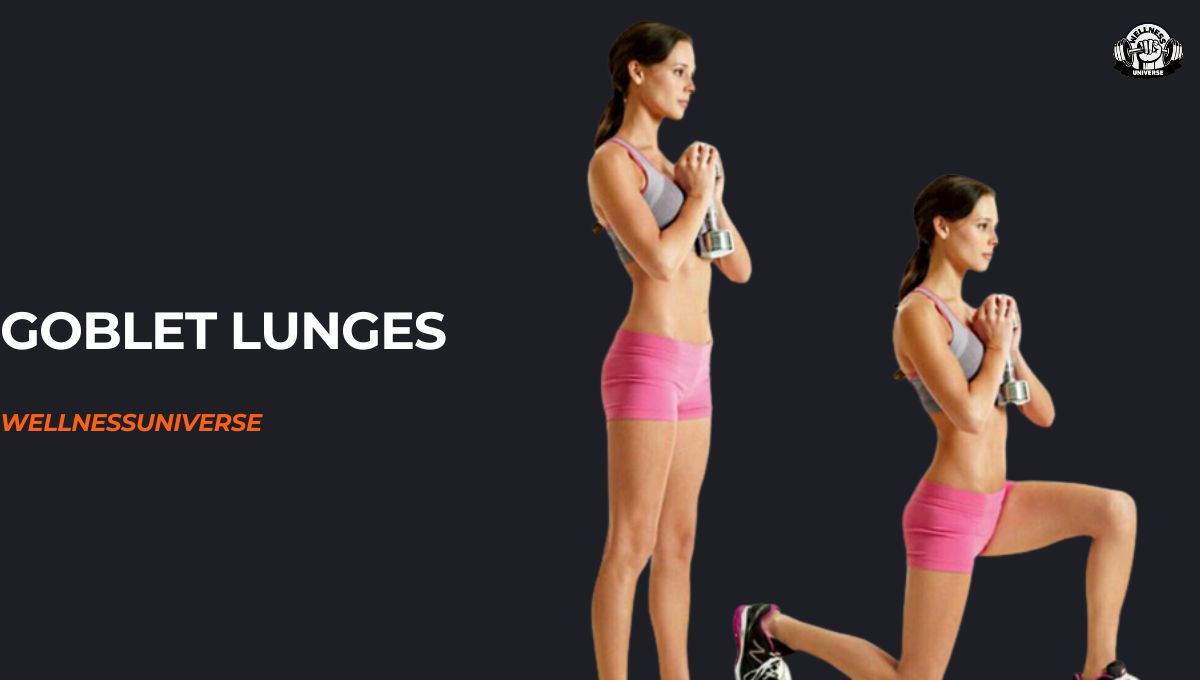The pendulum lunge is a dynamic and engaging lower body exercise that adds a unique twist to the traditional lunge movement. Unlike the standard forward or reverse lunges, the pendulum lunge involves a lateral movement pattern, making it an effective and challenging exercise for targeting various muscles while enhancing stability and balance.
Pendulum lunges offer a range of benefits that contribute to a well-rounded fitness routine. By incorporating lateral movement and multi-dimensional muscle activation, these lunges engage muscles in ways that standard lunges may not.
This engagement leads to improved functional strength and overall muscle balance. Additionally, the dynamic nature of the exercise helps enhance coordination and proprioception, leading to better balance and stability.
In this blog, we’ll delve into the world of pendulum lunges, exploring their mechanics, benefits, variations, and more. We’ll discuss how pendulum lunges target specific muscle groups and contribute to muscle growth and toning. You’ll also find guidance on proper form and technique to maximize the effectiveness of this exercise while minimizing the risk of injury.
Whether you’re a beginner looking to add variety to your routine or a seasoned fitness enthusiast aiming to challenge your strength and balance, this blog will provide valuable insights into the realm of pendulum lunges.
Performing Pendulum Lunges

The pendulum lunge movement is a dynamic exercise that involves a lateral stepping motion, mimicking the swing of a pendulum. To perform a pendulum lunge, start by standing upright with your feet hip-width apart. Take a lateral step to the side with one leg, keeping your toes pointing forward and your core engaged.
As you step to the side, your opposite leg will naturally swing back and away from the body, resembling the backward swing of a pendulum. Keep your chest up and maintain a neutral spine throughout the movement.
- Starting Position: Stand tall with your feet hip-width apart and your arms by your sides.
- Lateral Step: Take a lateral step to the side with one leg, maintaining a slight bend in your supporting knee.
- Pendulum Swing: As you step to the side, allow your opposite leg to swing back behind you, keeping it straight.
- Controlled Descent: Lower your body by bending your supporting knee and hips, similar to a traditional lunge.
- Lowering Depth: Aim to lower until your thigh is parallel to the ground or slightly below.
- Push Back: Push through the heel of your supporting leg to return to the starting position.
- Repeat: Perform the desired number of repetitions on one side before switching to the other.
Maintain a smooth and controlled motion throughout the exercise, focusing on balance and stability. Keep your core engaged to support your lower back and prevent any excessive leaning or twisting. As with any exercise, proper form is essential for maximizing the benefits and minimizing the risk of injury.
If you’re new to pendulum lunges, start with body weight only and gradually add resistance as you become more comfortable with the movement.
Benefits of Pendulum Lunges
Pendulum lunges provide a unique way to engage and challenge several muscle groups in the lower body. The lateral stepping motion places emphasis on the quadriceps, hamstrings, glutes, and adductors (inner thigh muscles) of the working leg. As you lower into the lunge position, the quadriceps of the supporting leg are also activated to stabilize your body.
Additionally, the swinging motion engages the hip flexors and abductors (outer hip muscles) of the leg that is moving backward. This comprehensive muscle engagement makes pendulum lunges an effective compound exercise for building strength and muscle tone in the lower body.
One of the significant benefits of pendulum lunges is the improvement of balance and stability. The lateral movement challenges your body to maintain equilibrium, activating the stabilizer muscles around your hips and core.
The need to balance on one leg while the other leg swings backward promotes better proprioception (awareness of your body’s position in space) and enhances your overall sense of balance. Strengthening these stabilizer muscles can contribute to injury prevention and better coordination, benefiting not only your workouts but also your daily activities.
Pendulum lunges closely mimic the lateral movements often encountered in everyday life. Actions like stepping sideways, getting in and out of a car, or maneuvering through a crowded space require lateral stability and strength. By training with pendulum lunges, you’re improving your ability to handle these real-life movements more efficiently and with a reduced risk of injury.
This functional fitness aspect makes pendulum lunges a valuable addition to your workout routine, as the benefits extend beyond the gym and into your daily routine.
Incorporating pendulum lunges into your training routine allows you to build strength, enhance balance, and improve functional fitness all in one exercise. As you engage various muscle groups and refine your stability, you’ll be better equipped to navigate both fitness challenges and everyday tasks with confidence and ease.
Variations and Progressions
- Split Stance Pendulum Lunge: This variation involves performing the pendulum lunge while maintaining a split stance. Instead of returning to the starting position after each rep, you remain in a slight lunge position with the back leg elevated. This variation intensifies the challenge on both legs and further engages your stabilizer muscles.
- Elevated Pendulum Lunge: In this version, you perform the pendulum lunge on an elevated surface such as a step or a platform. The elevation increases the range of motion and requires greater stability and strength from your working leg. It’s a more advanced variation that enhances muscle engagement and balance.
- Dynamic Pendulum Lunge: This dynamic version adds a hopping motion between pendulum lunges. After each lunge, you explosively push off the ground and switch to the other leg in mid-air. This variation combines the benefits of plyometric training with the lateral movement of the pendulum lunge, boosting power and agility.
Adding weights to your pendulum lunges can further amplify the intensity and effectiveness of the exercise. You can hold dumbbells by your sides or use a weighted vest to provide additional resistance. The added weight challenges your muscles to work harder and adapt to increased load, promoting muscle growth and strength gains over time.
Incorporating weights into pendulum lunges also enhances bone density and helps to burn more calories during the workout.
As you progress in your fitness journey, experimenting with advanced pendulum lunge variations and incorporating resistance can take your lower body training to the next level. These variations not only add diversity to your routine but also target your muscles from different angles, ensuring well-rounded development and continued progress.
Proper Form and Technique
- Overstepping: One common mistake is taking excessively large steps, which can compromise balance and stability. To avoid this, focus on taking controlled and moderate steps to maintain proper form throughout the movement.
- Leaning Forward: Leaning your torso forward while lunging can strain your lower back and disrupt the alignment of your body. Keep your upper body upright and engage your core to maintain a neutral spine position.
- Collapsing Knees: Allowing your knees to collapse inward as you lunge can strain the knee joints and lead to discomfort. Ensure that your knees are aligned with your ankles, tracking over your toes during the movement.
- Foot Placement: Start with your feet hip-width apart. As you lunge to one side, keep your toes pointing forward, and your knee should be in line with your ankle to prevent unnecessary stress on your joints.
- Posture: Maintain an upright posture throughout the movement. Imagine a straight line from your head to your heels, avoiding any leaning forward or backward.
- Range of Motion: When lunging to the side, aim to lower your hips until your thigh is parallel to the ground. This ensures proper engagement of your leg muscles while avoiding unnecessary strain on your joints.
- Core Engagement: Keep your core muscles activated to stabilize your torso and protect your lower back. Imagine pulling your belly button towards your spine throughout the movement.
By focusing on proper form and technique, you can maximize the benefits of pendulum lunges while minimizing the risk of injury. Pay attention to your body’s alignment and cues, and make adjustments as needed to maintain a safe and effective movement pattern.
In Crux
Pendulum lunges offer a dynamic and effective way to enhance your lower body strength, stability, and overall fitness. By incorporating this movement into your workout routine, you’re not only targeting multiple muscle groups but also improving your balance and functional fitness.
Embrace the versatility of pendulum lunges and consider how they can complement your existing training regimen.
As you embark on your fitness journey, remember that each movement you choose has the potential to make a significant impact on your health and well-being. Pendulum lunges exemplify the fusion of creativity and functionality in fitness training. By stepping into these lunges, you’re not only strengthening your muscles but also fortifying your body for the demands of daily life.
So, take the lessons learned from the pendulum lunge and apply them to other aspects of your fitness journey – a journey marked by continuous growth, exploration, and the pursuit of your best self.
FAQs about Pendulum Lunges
What are the benefits of incorporating pendulum lunges into my workout routine?
Pendulum lunges offer several benefits, including improved lower body strength, enhanced balance, and engagement of stabilizer muscles. They also simulate real-life movements, contributing to functional fitness.
Are pendulum lunges suitable for beginners or more advanced fitness levels?
Pendulum lunges can be adapted to various fitness levels. Beginners can start with the basic movement and gradually progress to more complex variations as they build strength and stability.
How do pendulum lunges target different muscle groups?
Pendulum lunges primarily target the quadriceps, hamstrings, glutes, and calf muscles. The swinging motion engages these muscles as they control the forward and backward movement of your leg.
Can pendulum lunges help improve balance and stability?
Absolutely. The swinging motion challenges your balance and forces stabilizer muscles to work, improving your overall stability and coordination.
Are there variations of pendulum lunges for an added challenge?
Yes, there are variations such as the split stance pendulum lunge, where the back foot is elevated, and the dynamic pendulum lunge, which involves jumping between lunges.
What is the correct form and technique for performing pendulum lunges?
Start by stepping into a lunge position, then swing your back leg forward and backward while maintaining proper posture. Keep your core engaged and focus on controlled movement.
How can I include pendulum lunges in a lower body workout?
You can incorporate pendulum lunges into a lower body workout routine by using them as one of your lunge variations. Include them alongside squats, deadlifts, and other lower body exercises.
Do pendulum lunges contribute to muscle growth and toning?
Yes, pendulum lunges engage multiple muscle groups, which can contribute to muscle growth and toning when combined with a balanced workout program.
Are there any common mistakes to avoid when doing pendulum lunges?
Common mistakes include not maintaining proper alignment, using excessive momentum, and overextending the swinging leg. Focus on controlled movements and proper form to avoid these errors.

Meet Pradeep Singh, your go-to guide for all things fitness, health, and motivation. With over 7 years in the field, Pradeep brings a blend of expertise and real-world experience to his writing. From workout tips to healthy living insights, he simplifies complex topics, making fitness accessible for everyone. His authentic approach and genuine passion aim to inspire and support your wellness journey. Get ready to embark on a path to a healthier lifestyle with Pradeep as your trusted companion and motivator.



















